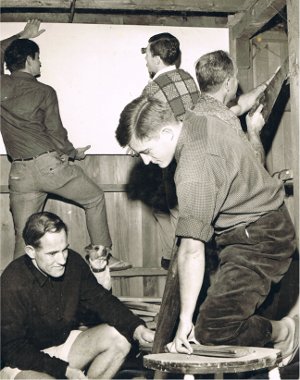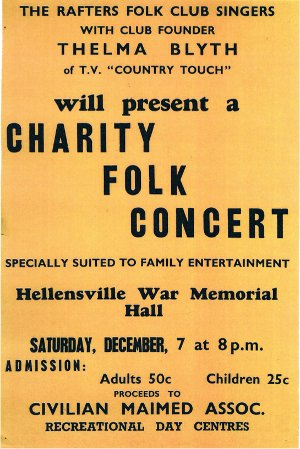By Wayne Facer
Read by Clay Nelson
Audio Playeror download the MP3
Download the PDF of this page.
Wayne Facer © 21 February 2016

- Noel attended at Kings College between 1930 and 1931 and then went to Ruakura College, Hamilton where he completed a Diploma in Agriculture. He worked on farms for a few years around the Hamilton area.
- When the pull of the city took hold and he returned to Auckland. He studied accountancy for Auckland University College and he worked and owned some milk bars which he later sold; he then worked at the State Advances Corporation, the government loan agency.
- By now he had started dancing and began teaching ball room dancing, but found he needed regular income so he got a job at Inland Revenue while continuing to teach dance. In 1947 he completed his diploma for the National Association of Teachers of Dance.
- Noel arranged a seminar on square dance and square dance calling, held at the Takapuna Boating Club Hall, in 1950. It wasn’t till after the 5th class that Noel got to dance with Thelma; they took to each other immediately and started going out.
- A year later they were married on 8 December 1951.
- Thelma came from a musical family, and was learning the violin when she met Noel. She worked with the proof readers at the Auckland Star and later moved into an office job doing clerical work.

- They both continued dancing and in Thelma’s case she learnt guitar and folk singing.
- When their daughter Ann reached intermediate school Noel and Thelma sought a suitable place where for her religious education. They looked at some traditional Church options but found them all wanting.
- They first heard of Unitarians through reading an American book about comparative religion. So in 1965 they visited the AUC but were disappointed to find it in a bad way: attendance 5 to 10 people, there was no minister, and no young people.

- By now the Blyth’s were full-time professional ballroom dance teachers with their own studio, Noel was also a professional photographer. Thelma was an up and coming folk singer and guitarist, having been a student of Willow Macky.

- They proposed that they provide a new family service once a month, beginning in April 1965. The management committee readily agreed.
- They removed the rubbish stored in the upstairs gallery, lighting was installed it was decorated with paintings and photos and became a coffee bar. Soon there would be 30 to 40 young people arriving at the gallery, sometimes there was a discussion forum, sometimes Thelma sang and coffee was always available.

- The Family Program as they called their services grew in attendances to around 100 people. Folk songs were sung, the congregation could join in. The sermon was in the form of short talks and usually with a dialogue between Thelma and Noel. Guest speakers were invited to deliver sermons, sometimes providing a more intellectual or in depth approach moral issues of the day. The Blyth’s approach was more down to earth and more engaging, while retaining a wide ranging religious content. They bought a humanist style of service to the church.

- It was during this period Hone Tuwhare (1922-2008) and his wife Jean McCormack attended with their family, (in Jean’s case returned to the church because her parents and maternal grandparents were members).
- After one of the services Hone told Noel and Thelma he had been moved to tears with Thelma’s rendition of “We shall Overcome”.

- The Humanists found the environment created by the Blyth’s very congenial and a number joined the church and began participating in services and other church activities, such as building the basement, digging out and lining downstairs, much to the appreciation of the Civilian Maimed Association, the Workers Educational Association and Citizens Association for Racial Equality who used the space. Some worked in the old library cataloguing and arranging the layout.
- The humanists were also encouraged by Eem Sikkema, a very active Unitarian with a humanist outlook, musical leader with a rich baritone voice, who assisted the Blyth’s and the humanist involvement. It was Eem who found the stage floor (which we still have) that Thelma and Noel wanted to present their services from rather than the pulpit. It was Noel who found the heaters to warm the Church in winter.

- Noel and Thelma realised with the success of the coffee gallery there was a need for a folk club and so Rafters was born. She used her musical talent and formed the Rafters Folk Club which had great success, and also supported the wider church community.
- Services were advertised under the head of “Humanist Viewpoint”, some examples from 1967:
Sunday 4th June 1967
10:30am The Gospel According to John Lennon & Noel Blyth presents a Humanist address written by an American Unitarian minister
7pm Coffee half hour
8pm Rafters Folk Song Club, Thelma Blyth plus Nigel Walmsley and guests
Sunday 18th June 1967
7pm Religion and Bertrand Russell
Noel presents a Humanist talk written by John Morgan Unitarian minister from Canada, followed by coffee
8pm Rafters Folk Song Club
- Numbers continued to grow, Sunday attendances around 100 with a large number of children, the Sunday school teacher was a science lecturer from the Teachers College who made the time interesting and fun for children to learn about the natural world. Publicity was generated in a lot of print media about the Family Program at the AUC culminating in a centre double page spread in the New Zealand Herald.
- Their success attracted interest from overseas. Attention focused on the dialogue presentation of sermons by Thelma and Noel, interspersed with ballads by Thelma. In October 1966 the UUA Church of the Larger Fellowship published a complete service that had been used by the Blyth’s. There was correspondence with a number of Unitarian ministers in the UK and Cape Town, South Africa, about the innovative service style which was producing such good attendances’ for religious services as well as social and musical events.
- By now the Blyth’s were putting in a considerable amount of time and resources and sought a small financial arrangement with the church committee to cover their expenses. Unfortunately the committee, possibly reflecting both an age and difference in religious outlook, would not agree to this request. Sadly the Blyth’s decided they could no longer continue and in July 1967 a notice appeared in News & Views saying their services would be discontinued.

- They continued supporting Rafters Folk Club for a further six months. Rafters became known as one of a handful of significant folk song clubs in the city.
- Thelma was included in the recording of the 1968 Banjo Pickers Convention, and was recorded performing at the Poles Apart Folk Club in Newmarket where she made a recording with the Hamilton County Bluegrass Band; she also recorded another album with the same Band comprising square dances.

- Thelma was Dance Caller on the TV series, Country Touch, which produced two highly successful television series.
- The loss of the Blyth’s services provoked a reproach from Elsie Blakey, daughter of one of the Church founders, wrote in News & Views, August 1967: “Because some of us have our roots in the Auckland Unitarian Church …it does not give us a proprietary right to say what shall and what shall not be done. ..It is better to have laughing happy children singing folk songs, than to be faced with a dying church…Because the Unitarian Movement has meant so much to me I would like to see it flourish once again and take its rightful place in the life of the community. I feel Jesus was the greatest Humanist.”
- While Nancy Fox, long time editor of the Unitarian Journal Motive wrote:
“The thanks and best wishes of Unitarians must go with [Noel and Thelma]…The last two and a half years of the Church have been greatly enlivened by their presence.” Nancy supported the Blyth’s efforts and Motive published a number of articles from Noel and Thelma.
- Noel reflected on their experience saying: “As far as Thelma and I are concerned, we have gained considerably, as persons, from our association with the church, it has not been time wasted-Thelma has developed into a leading folk singer, and we have both gained from the experience of speaking and running a progressive program.”
Our last slide is one of Thelma calling a dance on ‘Country Touch’, emphasis is on the Dancers – but Thelma is visible at the back and to the right; and we’re also got a video of this so we can see Thelma in action, but again the TV people’s emphasis is on the dancers, so it’s only a brief glimpse.
Video excerpt from TVNZ ‘The Country Touch’
Noel wasn’t left out of TV Stardom – here’s a piece about him from TV1s ‘Close Up’ programme – when he was still teaching dance at the age of 90.
Video excerpt from TVNZ ‘Close Up’
Legacy
- When Thelma and Noel started their Family Services the church was dying. They started a religious education program for children. Then they introduced the coffee evening in the gallery and expanded into the Rafters Folk Club. The church became alive with people of all ages and a vibrant community emerged. It had been the Blyth’s intention to revitalise the church and they certainly succeed in doing this, probably beyond their expectations. Publicity here and overseas generated a positive profile and attracted attention to their work. There was also a flow on benefit to the groups who used the church basement, especially the Civilian Maimed Association. Would it be too much to suggest that as a consequence of the Blyth’s efforts there was enough energy for the church to continue on until the appointment of Douglas Webster some three years later?

